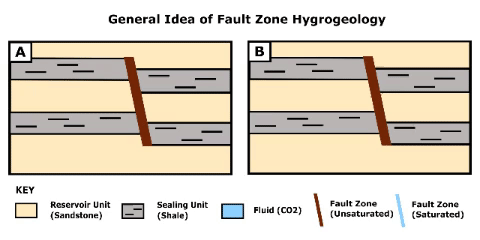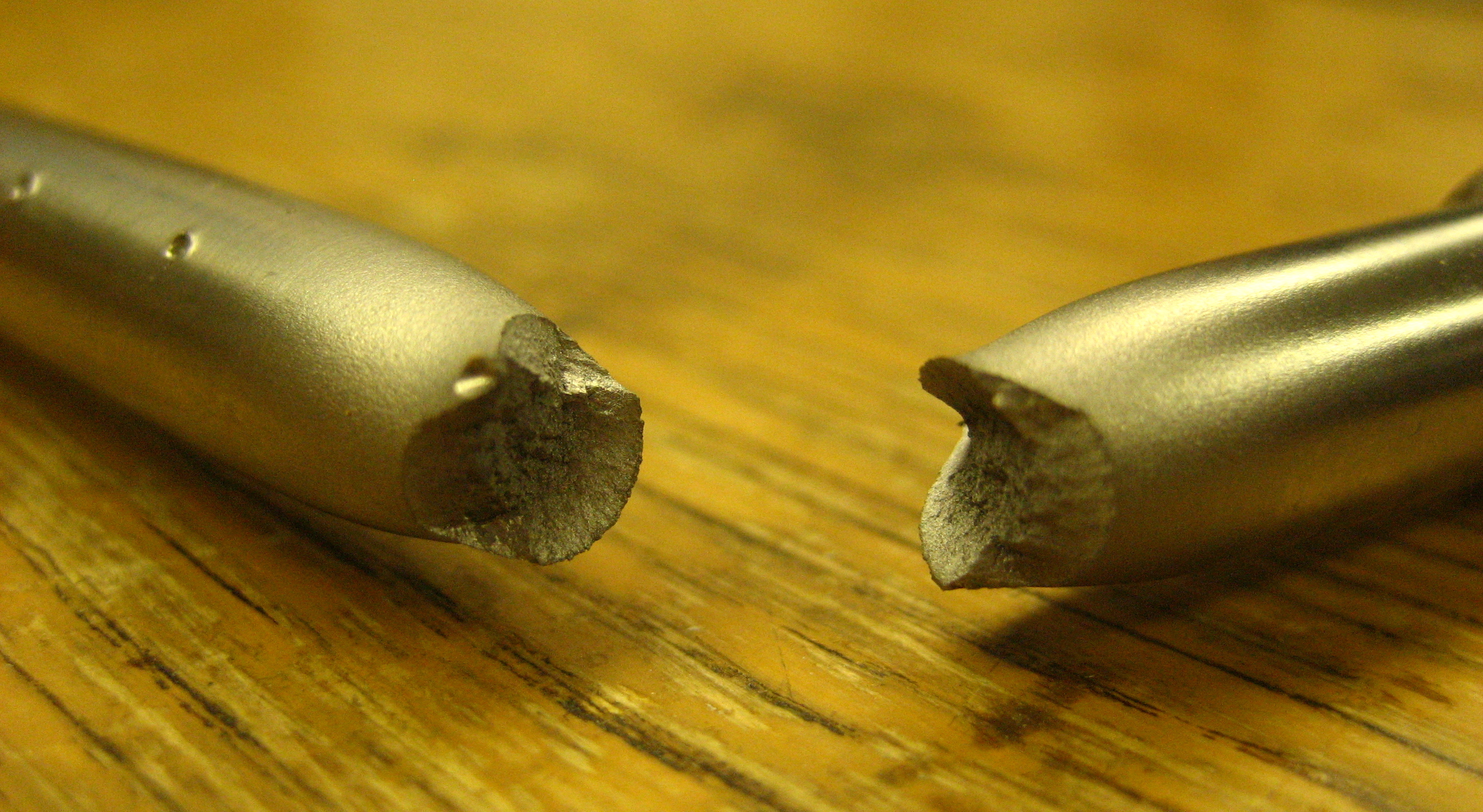|
Fault Zone Hydrogeology
Fault zone hydrogeology is the study of how brittlely deformed rocks alter fluid flows in different lithological settings, such as clastic, igneous and carbonate rocks. Fluid movements, that can be quantified as permeability, can be facilitated or impeded due to the existence of a fault zone. This is because different mechanisms that deform rocks can alter porosity and permeability within a fault zone. Fluids involved in a fault system generally are groundwater (fresh and marine waters) and hydrocarbons (Oil and Gas). *Please note that Permeability (k) and Hydraulic Conductivity (K) are used interchangeably in this article for simplified understanding__TOC__ Architecture A fault zone can be generally subdivided into two major sections, including a Fault Core (FC) and a Damage Zone (DZ) (Figure 1). The fault core is surrounded by the damage zone. It has a measurable thickness which increases with fault throw and displacement, i.e. increasing deformations. The damage zone ... [...More Info...] [...Related Items...] OR: [Wikipedia] [Google] [Baidu] |
Lithology
The lithology of a rock unit is a description of its physical characteristics visible at outcrop, in hand or core samples, or with low magnification microscopy. Physical characteristics include colour, texture, grain size, and composition. Lithology may refer to either a detailed description of these characteristics, or a summary of the gross physical character of a rock. Examples of lithologies in the second sense include sandstone, slate, basalt, or limestone. Lithology is the basis of subdividing rock sequences into individual lithostratigraphic units for the purposes of mapping and correlation between areas. In certain applications, such as site investigations, lithology is described using a standard terminology such as in the European geotechnical standard Eurocode 7. Rock type The naming of a lithology is based on the rock type. The three major rock types are igneous, sedimentary, and metamorphic. Igneous rocks are formed directly from magma, which is a mixture of ... [...More Info...] [...Related Items...] OR: [Wikipedia] [Google] [Baidu] |
Comminution
Comminution is the reduction of solid materials from one average particle size to a smaller average particle size, by crushing, grinding, cutting, vibrating, or other processes. In geology, it occurs naturally during faulting in the upper part of the Earth's crust. In industry, it is an important unit operation in mineral processing, ceramics, electronics, and other fields, accomplished with many types of mill. In dentistry, it is the result of mastication of food. In general medicine, it is one of the most traumatic forms of bone fracture. Within industrial uses, the purpose of comminution is to reduce the size and to increase the surface area of solids. It is also used to free useful materials from matrix materials in which they are embedded, and to concentrate minerals. Energy requirements The comminution of solid materials consumes energy, which is being used to break up the solid into smaller pieces. The comminution energy can be estimated by: * Rittinger's law, whi ... [...More Info...] [...Related Items...] OR: [Wikipedia] [Google] [Baidu] |
Silicate Mineral
Silicate minerals are rock-forming minerals made up of silicate groups. They are the largest and most important class of minerals and make up approximately 90 percent of Earth's crust. In mineralogy, silica (silicon dioxide, ) is usually considered a silicate mineral. Silica is found in nature as the mineral quartz, and its polymorphs. On Earth, a wide variety of silicate minerals occur in an even wider range of combinations as a result of the processes that have been forming and re-working the crust for billions of years. These processes include partial melting, crystallization, fractionation, metamorphism, weathering, and diagenesis. Living organisms also contribute to this geologic cycle. For example, a type of plankton known as diatoms construct their exoskeletons ("frustules") from silica extracted from seawater. The frustules of dead diatoms are a major constituent of deep ocean sediment, and of diatomaceous earth. General structure A silicate mineral is generally ... [...More Info...] [...Related Items...] OR: [Wikipedia] [Google] [Baidu] |
Clay Smear
Clay is a type of fine-grained natural soil material containing clay minerals (hydrous aluminium phyllosilicates, e.g. kaolin, Al2 Si2 O5( OH)4). Clays develop plasticity when wet, due to a molecular film of water surrounding the clay particles, but become hard, brittle and non–plastic upon drying or firing. Most pure clay minerals are white or light-coloured, but natural clays show a variety of colours from impurities, such as a reddish or brownish colour from small amounts of iron oxide. Clay is the oldest known ceramic material. Prehistoric humans discovered the useful properties of clay and used it for making pottery. Some of the earliest pottery shards have been dated to around 14,000 BC, and clay tablets were the first known writing medium. Clay is used in many modern industrial processes, such as paper making, cement production, and chemical filtering. Between one-half and two-thirds of the world's population live or work in buildings made with clay, ofte ... [...More Info...] [...Related Items...] OR: [Wikipedia] [Google] [Baidu] |
Tortuosity
Tortuosity is widely used as a critical parameter to predict transport properties of porous media, such as rocks and soils. But unlike other standard microstructural properties, the concept of tortuosity is vague with multiple definitions and various evaluation methods introduced in different contexts. Hydraulic, electrical, diffusional, and thermal tortuosities are defined to describe different transport processes in porous media, while geometrical tortuosity is introduced to characterize the morphological property of porous microstructures. Tortuosity in 2-D Subjective estimation (sometimes aided by optometric grading scales) is often used. The simplest mathematical method to estimate tortuosity is the arc-chord ratio: the ratio of the length of the curve (''C'') to the distance between its ends (''L''): :\tau = \frac Arc-chord ratio equals 1 for a straight line and is infinite for a circle. Another method, proposed in 1999, is to estimate the tortuosity as the integral o ... [...More Info...] [...Related Items...] OR: [Wikipedia] [Google] [Baidu] |
Sorting (sediment)
Sorting describes the distribution of grain size of sediments, either in unconsolidated deposits or in sedimentary rocks. This should not be confused with crystallite size, which refers to the individual size of a crystal in a solid. Crystallite is the building block of a grain. ''Very poorly sorted'' indicates that the sediment sizes are mixed (large variance); whereas ''well sorted'' indicates that the sediment sizes are similar (low variance). The terms describing sorting in sediments – very poorly sorted, poorly sorted, moderately sorted, well sorted, very well sorted – have technical definitions and semi-quantitatively describe the amount of variance seen in particle sizes. See for details. In the field, sedimentologists use graphical charts to accurately describe the sorting of a sediment using one of these terms. The degree of sorting may also indicate the energy, rate, and/or duration of deposition, as well as the transport process (river, debris flow, wind, glacier ... [...More Info...] [...Related Items...] OR: [Wikipedia] [Google] [Baidu] |
Micrometre
The micrometre ( international spelling as used by the International Bureau of Weights and Measures; SI symbol: μm) or micrometer ( American spelling), also commonly known as a micron, is a unit of length in the International System of Units (SI) equalling (SI standard prefix " micro-" = ); that is, one millionth of a metre (or one thousandth of a millimetre, , or about ). The nearest smaller common SI unit is the nanometre, equivalent to one thousandth of a micrometre, one millionth of a millimetre or one billionth of a metre (). The micrometre is a common unit of measurement for wavelengths of infrared radiation as well as sizes of biological cells and bacteria, and for grading wool by the diameter of the fibres. The width of a single human hair ranges from approximately 20 to . The longest human chromosome, chromosome 1, is approximately in length. Examples Between 1 μm and 10 μm: * 1–10 μm – length of a typical bacterium * 3–8 μm � ... [...More Info...] [...Related Items...] OR: [Wikipedia] [Google] [Baidu] |
Fracture
Fracture is the separation of an object or material into two or more pieces under the action of stress. The fracture of a solid usually occurs due to the development of certain displacement discontinuity surfaces within the solid. If a displacement develops perpendicular to the surface, it is called a normal tensile crack or simply a crack; if a displacement develops tangentially, it is called a shear crack, slip band or dislocation. Fracture#Brittle, Brittle fractures occur with no apparent deformation before fracture. Fracture#Ductile, Ductile fractures occur after visible deformation. Fracture strength, or breaking strength, is the stress when a specimen fails or fractures. The detailed understanding of how a fracture occurs and develops in materials is the object of fracture mechanics. Strength Fracture strength, also known as breaking strength, is the stress at which a specimen Structural integrity and failure, fails via fracture. This is usually determined for a gi ... [...More Info...] [...Related Items...] OR: [Wikipedia] [Google] [Baidu] |
Matrix (geology)
The matrix or groundmass of a rock is the finer-grained mass of material in which larger grains, crystals, or clasts are embedded. The matrix of an igneous rock consists of finer-grained, often microscopic, crystals in which larger crystals, called phenocrysts, are embedded. This porphyritic texture is indicative of multi-stage cooling of magma. For example, porphyritic andesite will have large phenocrysts of plagioclase in a fine-grained matrix. Also in South Africa, diamonds are often mined from a matrix of weathered clay-like rock ( kimberlite) called "yellow ground". The matrix of sedimentary rocks is finer-grained sedimentary material, such as clay or silt, in which larger grains or clasts are embedded. It is also used to describe the rock material in which a fossil is embedded. Cementation All sediments are at first in an incoherent condition (e.g. sands, clays and gravels, beds of shells), and they may remain in this state for an indefinite period. Millions of ye ... [...More Info...] [...Related Items...] OR: [Wikipedia] [Google] [Baidu] |
Breccia
Breccia () is a rock composed of large angular broken fragments of minerals or rocks cemented together by a fine-grained matrix. The word has its origins in the Italian language, in which it means "rubble". A breccia may have a variety of different origins, as indicated by the named types including sedimentary breccia, tectonic breccia, igneous breccia, impact breccia, and hydrothermal breccia. A megabreccia is a breccia composed of very large rock fragments, sometimes kilometers across, which can be formed by landslides, impact events, or caldera collapse. Types Breccia is composed of coarse rock fragments held together by cement or a fine-grained matrix. Like conglomerate, breccia contains at least 30 percent of gravel-sized particles (particles over 2mm in size), but it is distinguished from conglomerate because the rock fragments have sharp edges that have not been worn down. These indicate that the gravel was deposited very close to its source area, since other ... [...More Info...] [...Related Items...] OR: [Wikipedia] [Google] [Baidu] |






